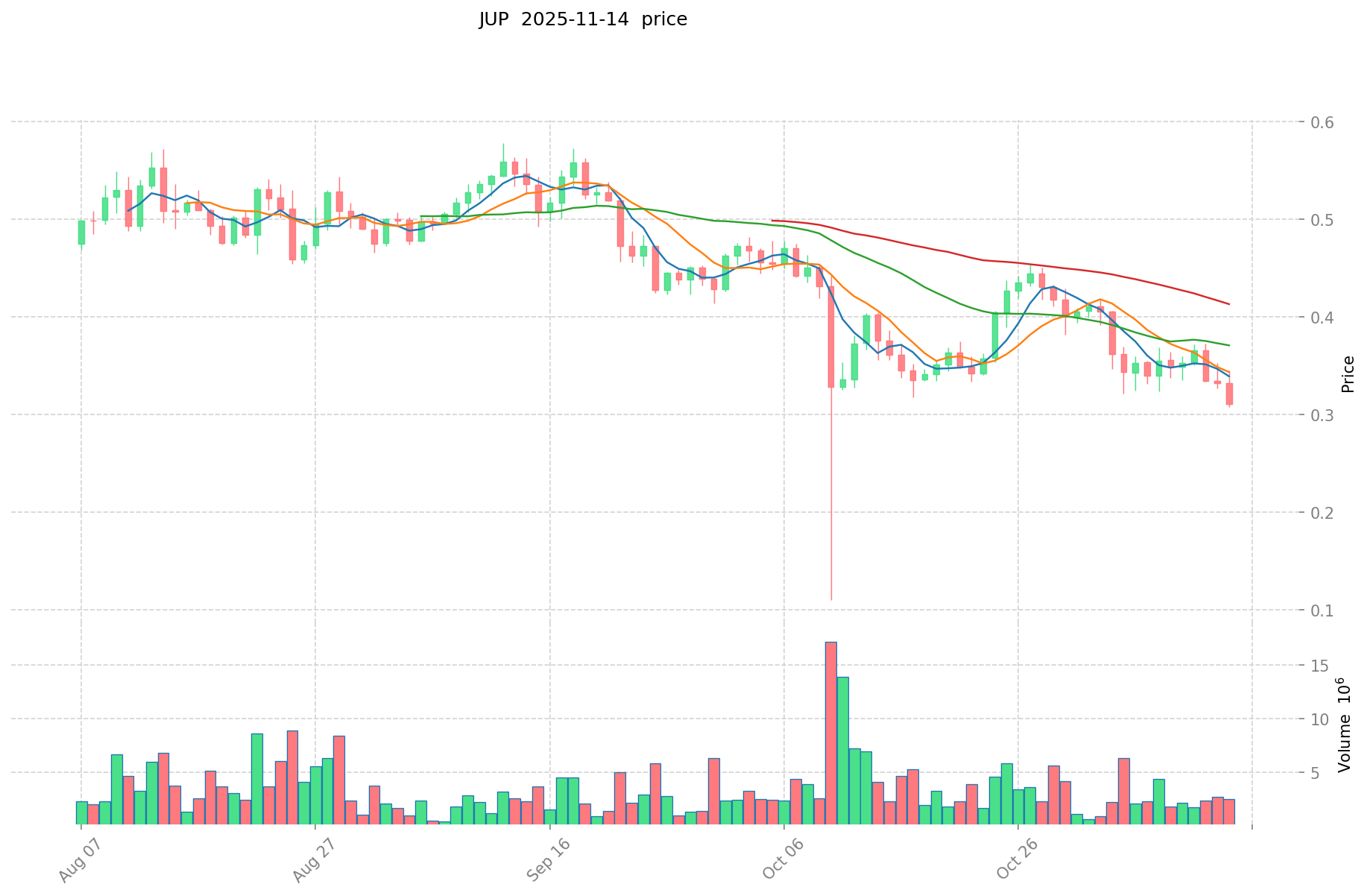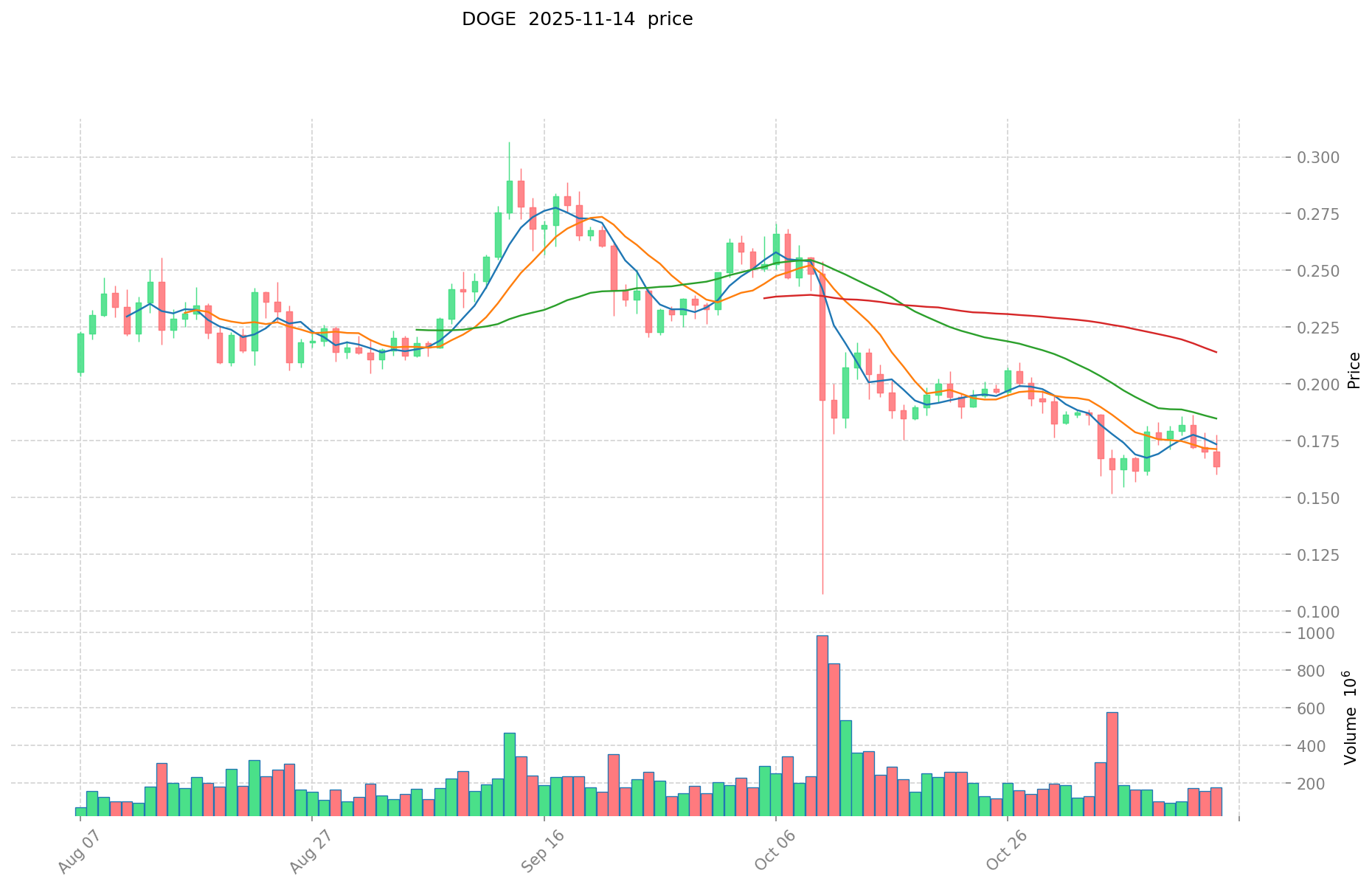JUP vs DOGE: The Battle of Meme Coins in the Crypto Arena
Introduction: JUP vs DOGE Investment Comparison
In the cryptocurrency market, Jupiter (JUP) vs Dogecoin (DOGE) comparison has always been a topic that investors can't ignore. The two not only have significant differences in market cap ranking, application scenarios, and price performance, but also represent different positioning of crypto assets.
Jupiter (JUP): Since its launch, it has gained market recognition for being the leading DeFi dApp on Solana and serving as Solana's primary liquidity infrastructure.
Dogecoin (DOGE): Since its inception in December 2013, it has been hailed as a fun, light-hearted cryptocurrency, and is the second largest virtual currency in the world after Bitcoin in terms of user base.
This article will comprehensively analyze the investment value comparison between JUP and DOGE, focusing on historical price trends, supply mechanisms, institutional adoption, technical ecosystems, and future predictions, and attempt to answer the question that concerns investors the most:
"Which is the better buy right now?"
I. Price History Comparison and Current Market Status
JUP (Coin A) and DOGE (Coin B) Historical Price Trends
- 2024: JUP reached its all-time high of $2.2 on January 31, 2024, likely due to significant market momentum or project developments.
- 2021: DOGE experienced a substantial price surge, reaching its all-time high of $0.731578 on May 8, 2021, influenced by social media attention and celebrity endorsements.
- Comparative analysis: In the recent market cycle, JUP has declined from its peak of $2.2 to the current price of $0.2827, while DOGE has fallen from its all-time high of $0.731578 to $0.15876, showing significant retracements for both coins.
Current Market Situation (2025-11-15)
- JUP current price: $0.2827
- DOGE current price: $0.15876
- 24-hour trading volume: JUP $1,146,622.88 vs DOGE $24,993,923.18
- Market Sentiment Index (Fear & Greed Index): 16 (Extreme Fear)
Click to view real-time prices:
- View JUP current price Market Price
- View DOGE current price Market Price


II. Core Factors Affecting Investment Value of JUP vs DOGE
Supply Mechanism Comparison (Tokenomics)
- JUP: Jupiter has a fixed maximum supply of 10 billion tokens. 1 billion JUP was allocated to initial airdrop distribution, with the remaining 9 billion allocated to the project treasury for future use over 54 months.
- DOGE: Dogecoin has an inflationary supply model with approximately 5 billion new DOGE created annually. Unlike most cryptocurrencies, it has no maximum supply cap.
- 📌 Historical Pattern: Fixed supply tokens like JUP tend to appreciate in value over time if demand increases, while DOGE's inflationary model may limit long-term price growth despite popularity surges.
Institutional Adoption and Market Applications
- Institutional Holdings: DOGE has received more institutional attention historically, particularly with Elon Musk's endorsement and Tesla's brief acceptance of DOGE for merchandise.
- Enterprise Adoption: DOGE has established more real-world payment use cases with merchants and platforms that accept it for payments, while JUP is still developing its utility beyond the Solana ecosystem.
- National Policies: Both tokens face similar regulatory scrutiny as most cryptocurrencies, with neither having special regulatory advantages in major jurisdictions.
Technical Development and Ecosystem Building
- JUP Technical Upgrades: Jupiter is developing its perpetual DEX platform and expanding its liquidity aggregation capabilities across the Solana ecosystem.
- DOGE Technical Development: Dogecoin has implemented minor technical improvements focused on security and efficiency, with relatively slower development compared to newer protocols.
- Ecosystem Comparison: JUP has stronger DeFi functionality within the Solana ecosystem with its DEX aggregation services, while DOGE has broader general payment adoption but limited smart contract or DeFi capabilities.
Macroeconomic Factors and Market Cycles
- Performance in Inflationary Environments: Neither asset has demonstrated consistent inflation-hedging properties, though JUP's fixed supply model theoretically provides better protection against inflation than DOGE's unlimited supply.
- Macroeconomic Monetary Policy: Both assets show sensitivity to Federal Reserve policy changes and broader crypto market sentiment, with risk-on environments typically benefiting both tokens.
- Geopolitical Factors: Neither token has demonstrated significant advantages in cross-border transactions compared to other major cryptocurrencies.
III. 2025-2030 Price Predictions: JUP vs DOGE
Short-term Prediction (2025)
- JUP: Conservative $0.194616 - $0.2862 | Optimistic $0.2862 - $0.331992
- DOGE: Conservative $0.1409056 - $0.16012 | Optimistic $0.16012 - $0.2385788
Mid-term Prediction (2027)
- JUP may enter a growth phase, with prices expected in the range of $0.1840357584 - $0.460089396
- DOGE may enter a consolidation phase, with prices expected in the range of $0.14568454152 - $0.23673737997
- Key drivers: Institutional capital inflow, ETF, ecosystem development
Long-term Prediction (2030)
- JUP: Base scenario $0.4893183444555 - $0.56740539145249 | Optimistic scenario $0.56740539145249 - $0.66547294845948
- DOGE: Base scenario $0.246475885721509 - $0.289609165722773 | Optimistic scenario $0.289609165722773 - $0.332742445724037
Disclaimer: This information is for educational purposes only and should not be considered as financial advice. Cryptocurrency markets are highly volatile and unpredictable. Always conduct your own research before making any investment decisions.
JUP:
| 年份 | 预测最高价 | 预测平均价格 | 预测最低价 | 涨跌幅 |
|---|---|---|---|---|
| 2025 | 0.331992 | 0.2862 | 0.194616 | 1 |
| 2026 | 0.39873384 | 0.309096 | 0.18236664 | 9 |
| 2027 | 0.460089396 | 0.35391492 | 0.1840357584 | 25 |
| 2028 | 0.4477023738 | 0.407002158 | 0.33781179114 | 43 |
| 2029 | 0.551284423011 | 0.4273522659 | 0.294873063471 | 51 |
| 2030 | 0.66547294845948 | 0.4893183444555 | 0.28380463978419 | 73 |
DOGE:
| 年份 | 预测最高价 | 预测平均价格 | 预测最低价 | 涨跌幅 |
|---|---|---|---|---|
| 2025 | 0.2385788 | 0.16012 | 0.1409056 | 0 |
| 2026 | 0.205329882 | 0.1993494 | 0.175427472 | 25 |
| 2027 | 0.23673737997 | 0.202339641 | 0.14568454152 | 27 |
| 2028 | 0.2590554423723 | 0.219538510485 | 0.1800215785977 | 38 |
| 2029 | 0.253654795014369 | 0.23929697642865 | 0.169900853264341 | 50 |
| 2030 | 0.332742445724037 | 0.246475885721509 | 0.133096978289615 | 55 |
IV. Investment Strategy Comparison: JUP vs DOGE
Long-term vs Short-term Investment Strategies
- JUP: Suitable for investors focused on DeFi ecosystem potential and Solana network growth
- DOGE: Suitable for investors seeking short-term trading opportunities and community-driven price movements
Risk Management and Asset Allocation
- Conservative investors: JUP: 30% vs DOGE: 70%
- Aggressive investors: JUP: 60% vs DOGE: 40%
- Hedging tools: Stablecoin allocation, options, cross-currency portfolios
V. Potential Risk Comparison
Market Risk
- JUP: High volatility due to smaller market cap and dependency on Solana ecosystem
- DOGE: Susceptibility to social media influence and celebrity endorsements
Technical Risk
- JUP: Scalability, network stability of Solana blockchain
- DOGE: Mining centralization, security vulnerabilities
Regulatory Risk
- Global regulatory policies may impact both tokens, with DOGE potentially facing less scrutiny due to its established history
VI. Conclusion: Which Is the Better Buy?
📌 Investment Value Summary:
- JUP advantages: Strong DeFi functionality, fixed supply, potential for ecosystem growth
- DOGE advantages: Wide recognition, large user base, established payment use cases
✅ Investment Advice:
- Novice investors: Consider a small allocation to DOGE for exposure to crypto markets
- Experienced investors: Explore JUP for its DeFi potential within a diversified portfolio
- Institutional investors: Evaluate JUP for its role in Solana's DeFi ecosystem, while considering DOGE for its liquidity and market presence
⚠️ Risk Warning: The cryptocurrency market is highly volatile. This article does not constitute investment advice. None
VII. FAQ
Q1: What are the main differences between JUP and DOGE in terms of supply mechanisms? A: JUP has a fixed maximum supply of 10 billion tokens, while DOGE has an inflationary supply model with approximately 5 billion new DOGE created annually and no maximum supply cap.
Q2: How do JUP and DOGE compare in terms of institutional adoption? A: DOGE has historically received more institutional attention, particularly with endorsements from figures like Elon Musk and Tesla's brief acceptance for merchandise payments. JUP, being newer, is still developing its institutional presence.
Q3: Which coin has shown better price performance in recent years? A: In the recent market cycle, JUP reached its all-time high of $2.2 in January 2024, while DOGE hit its peak of $0.731578 in May 2021. Both have since experienced significant retracements.
Q4: What are the key ecosystems and use cases for JUP and DOGE? A: JUP is primarily focused on DeFi functionality within the Solana ecosystem, offering DEX aggregation services. DOGE has broader general payment adoption but limited smart contract or DeFi capabilities.
Q5: How do the long-term price predictions for JUP and DOGE compare? A: By 2030, JUP's base scenario predicts a range of $0.4893183444555 - $0.56740539145249, while DOGE's base scenario predicts $0.246475885721509 - $0.289609165722773.
Q6: What are the main risks associated with investing in JUP and DOGE? A: JUP faces risks related to high volatility due to its smaller market cap and dependency on the Solana ecosystem. DOGE is susceptible to social media influence and celebrity endorsements, which can cause price volatility.
Q7: How might different types of investors approach JUP and DOGE? A: Novice investors might consider a small allocation to DOGE for exposure to crypto markets. Experienced investors could explore JUP for its DeFi potential within a diversified portfolio. Institutional investors might evaluate JUP for its role in Solana's DeFi ecosystem while considering DOGE for its liquidity and market presence.
Share
Content